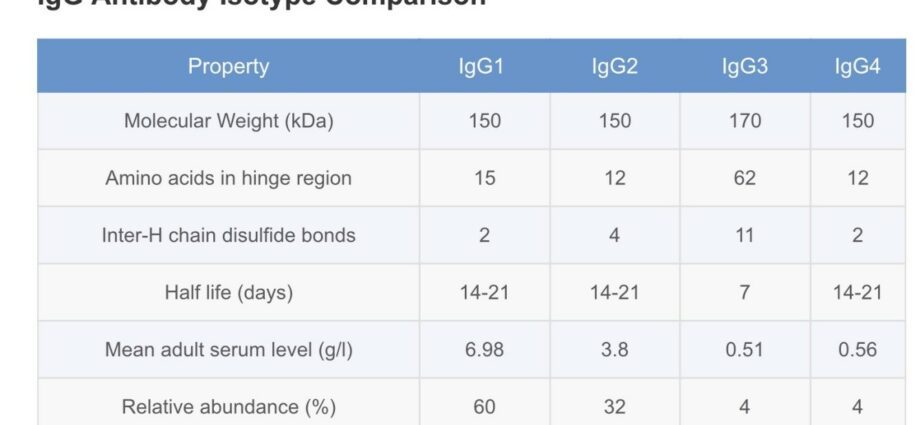Contents
IGG: what does the immunoglobulin G level correspond to?
Immunoglobulin G is an antibody that participates in the body’s defense. Its level in the body is an indicator of the functioning state of the immune system and / or the presence of a possible infection.
What is immunoglobulin G?
Antibodies are part of the immune system, which is the body’s defense system. An immunoglobulin is a protein that is part of the antibody family. Immunoglobulin is a soluble antibody, that is, it is not attached to a cell. It is produced by cells of the immune system called B lymphocytes.
There are different types of immunoglobulins. Immunoglobulins G (IgG) represent 70 to 80% of total immunoglobulins. They are Y-shaped and have two antibody sites, that is to say they have the ability to bind two antigens which are elements found on the surface of foreign bodies to the body such as viruses or bacteria. There are 4 subtypes of IgG:
- IgG1;
- IgG2;
- IgG3;
- IgG4.
IgGs are found in interstitial fluid (which bridges the gap between cells and blood capillaries) and in the blood.
Immunoglobulins G help fight bacterial, viral or fungal infections that attack organic tissues. Indeed, when a pathogen enters the body, it is recognized by a specific antibody. This will attach to the corresponding antigen to indicate to the rest of the immune system the presence of the intruder. As a result, the pathogen is eliminated by the body’s defenders. The production of immunoglobulins G therefore increases when exposed to bacteria or viruses. The first time you are exposed to a given antigen, your body will need to find the right antibody. After infection, the body retains copies of the antibody, so that it can react more quickly in the event of a new infection.
The level of immunoglobulin G may vary in a normal way depending on:
- age: at birth, the newborn has between 7 and 13 grams per liter of immunoglobulin G. Indeed, these are able to cross the placental barrier and were therefore inherited from the mother. At the end of 4 to 6 months of life, the organism of the newborn synthesizes its own immunoglobulins G. From 6 years, the level of immunoglobulins G is the same as in adults;
- sex: from the age of 7, women have a higher IgG level than men, around 2 to 30% higher;
- of the geographical area: the level of IgG is approximately twice as high in the inhabitants of tropical regions than in the inhabitants of temperate regions.
Why do an immunoglobulin G test?
Immunoglobulin G assays are frequent reviews. They are carried out in order to give the doctor an idea of the state of the immune system. They are for example indicated when an immune deficiency is suspected in the case of certain infections such as AIDS or the zone, or in the event of repeated infections. They are also used for monitoring various diseases.
In the case of a newborn baby, the IgG test may be useful in diagnosing an infection. If there are no infections, the IgG level will gradually decrease until it reaches the normal level in the child. Conversely, in case of infection, the IgG level will not decrease (the child’s body producing more to compensate for the loss of maternal IgG and fight the infection).
How is an immunoglobulin G assay performed?
The dosage of immunoglobulin G begins with a blood test, prescribed by the doctor. There is no need to be fasting. At the medical analysis laboratory, certain information will be requested concerning the patient, his current treatments and the reason for this dosage.
From the sample obtained by the blood sample, the laboratory will do tests to determine the amount of immunoglobulin G. For this, the technique most often used is the electrophoresis of serum proteins. This is a method that allows the separation of proteins on a gel using an electric current. Depending on its size and mobility, each protein will take up a place. This method also makes it possible to estimate the quantity of each of these proteins.
The results ?
The level of immunoglobulin G can vary pathologically. There are two possibilities :
- the IgG level is lower than normal. This usually indicates a decrease in the functioning of the immune system or a less efficient functioning. It can be caused by congenital immunity deficit, autoimmune disease, viral infection, etc. As a result, the body is less well protected against infections. This low level of IgG can also have a genetic cause or be the consequence of a treatment;
- the IgG level is higher than normal. It is usually the consequence of an activation of the immune system. If the immune system is activated, it is to defend the body. This can be, for example, the consequence of contamination by a bacteria or a virus.










